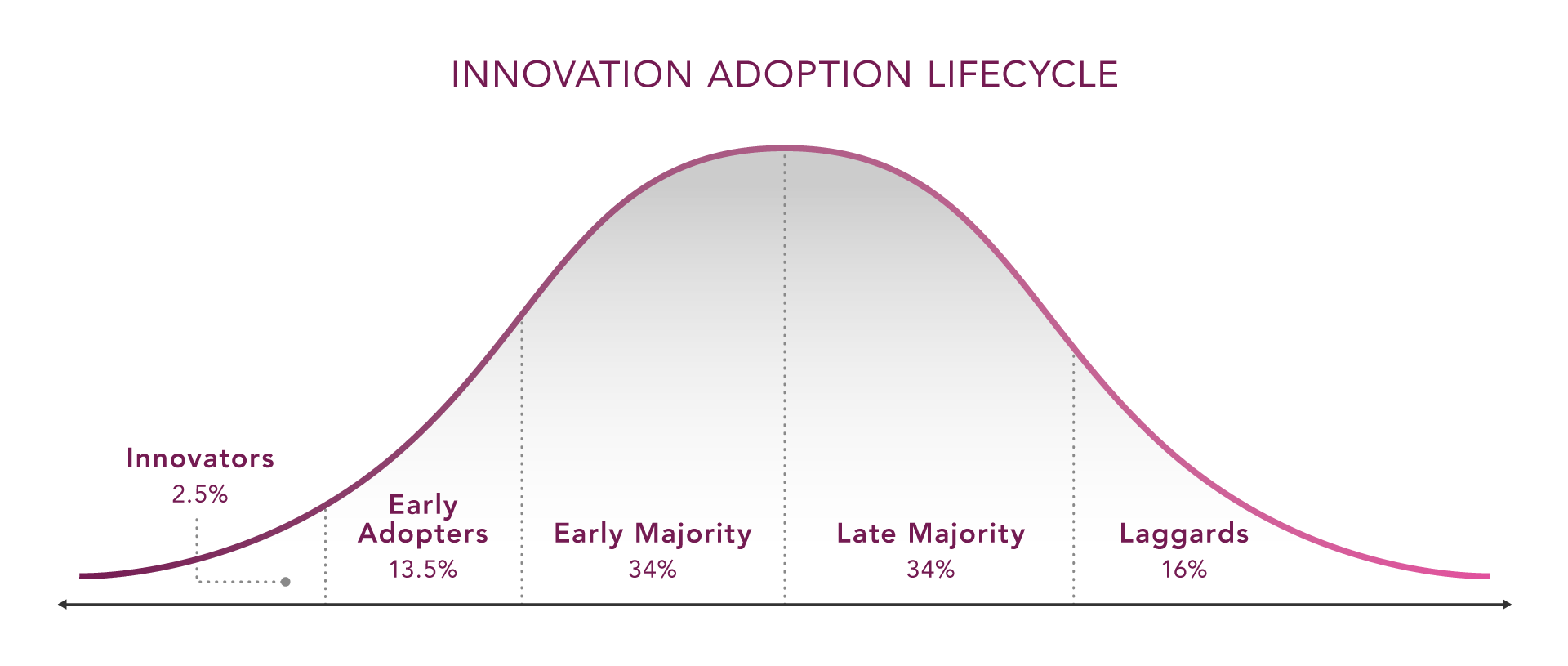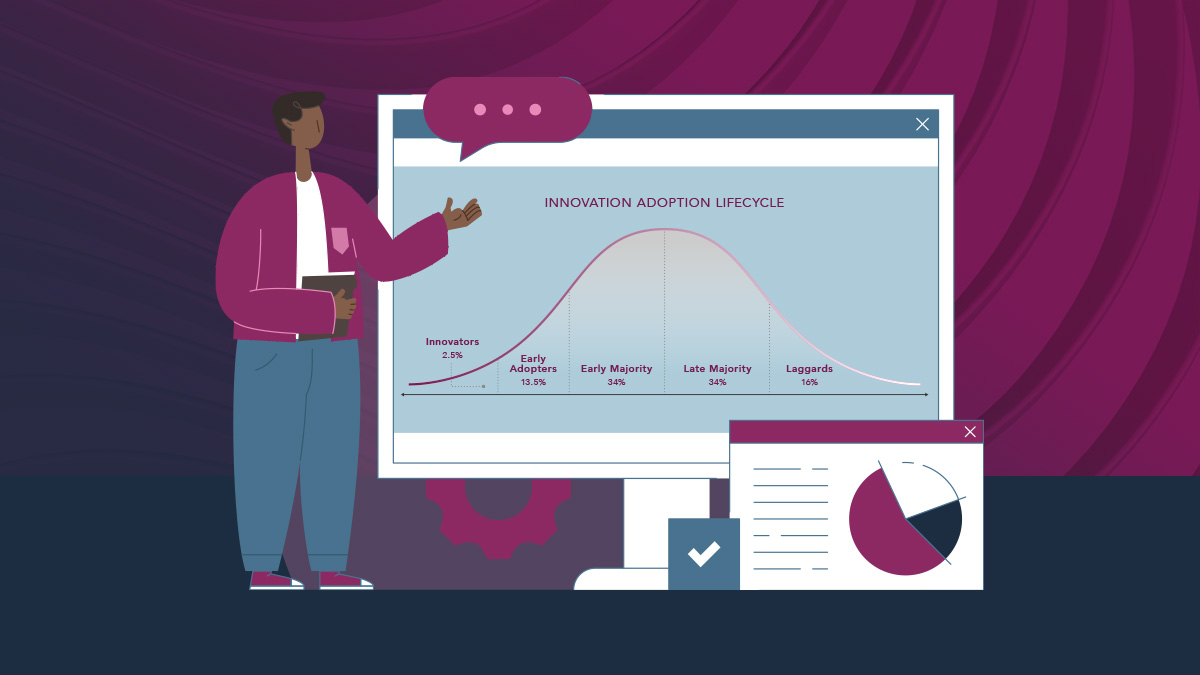Diffusion of Innovations Theory, developed by Everett M. Rogers in 1962, is a framework that explains how an idea, product or behavior is adopted over time by a population or society. It portrays how it gains momentum and spreads or “diffuses” through a social system. But the word “adoption” in this instance must also be defined. It refers to a person doing something they have not done before, so essentially, it is a new “innovation.”
Diffusion of Innovations Theory can help us understand where our product or service is in its lifecycle and how our communications challenges and objectives differ at each stage.
There Are Five Types of Adopters to Consider When Developing A Communications Campaign
Before diving into a communications campaign, practitioners must consider who their target audience is and understand their adoption process. By understanding the characteristics, needs and motivations of these groups, we can more clearly define appropriate tactics and messaging for that particular population. Below is a diagram of the five types of innovation adopters.

Innovators
Innovators are those people that want to be the first to try something new. They take the shortest time to adopt and are willing to take risks; they need little convincing or motivation. Innovators see themselves as influencers; they love testing new products and sharing their opinions to persuade others. They generally don’t care if the product is in the beta phase. They tolerate risk and usually have the financial means to adopt the new product even if it may fail.
Elon Musk is the perfect example of an Innovator. He is known for his groundbreaking ideas and visionary approach. For example, he revolutionized the automotive industry by pushing for mass production of electric vehicles, making them more accessible to the mainstream market.
From a communications perspective, if trying to get the attention of this category of adopters, they are enticed by disruption, cutting-edge technology or challenging the status quo. Media outlets that cover emerging trends, new technologies and are at the forefront of new ideas, such as Wired, Fast Company and Harvard Business Review, will be key in reaching Innovators.
On the other side of the coin, there are a few challenges to consider when targeting Innovators. Because they are willing to take risks, they may be more critical, demanding and have high expectations. Make sure that you can deliver on whatever messaging you employ and promises you make. Additionally, they are a very small percentage of the market, so it may be difficult to make a lot of headway in penetrating the marketplace.
Early Adopters
Early Adopters are leaders and play an important role in the adoption process. They embrace change and like adopting new ideas, so they don’t need to be convinced. Like Innovators, they also like to influence others, so they are generally the first to share their experiences. They are strongly opinionated, like being changemakers and are driven by experimentation, unique opportunities and are always looking for a competitive advantage.
For example, Early Adopters are those that will pre-order the new iPhone before it comes out or wait in line the day it does. Other than knowing that a new iPhone is being released, they need no further information to drive them to purchase. They follow tech blogs and participate in online discussions about new technology.
A communication campaign targeting Early Adopters will highlight messaging that announces a new innovation and promotes shaping the future. To appeal to the early adopter, tactics should call attention to an exciting change in an industry, an opportunity to be the first to experience the product and encourage them to share their opinion. Early Adopters read a lot of blogs, online forums and industry specific publications and listen to podcasts and consume video content on YouTube and other outlets.
While there are a lot of advantages to targeting Early Adopters, also consider that their zest for new innovations and technology also means higher expectations. If those expectations aren’t met, you risk negative feedback that can be diffused among their circle of influence. Since they are driven by having or experiencing the latest and greatest, they may not be brand loyal. They will quickly move to the next best thing.
Early Majority
The Early Majority aren’t really leaders, but they will adopt new innovations before others. They need to see evidence that the product has been proven successful, is reliable, practical and offers tangible benefits. They look to Innovators and Early Adopters for recommendations, read reviews and rely heavily on social influence to minimize risk. Because they are the majority of adopters (34%), they can make or break an innovation and heavily impact mainstream adoption.
The adoption of smartphones is an example of the Early Majority playing a major role in the adoption of an innovation. They recognized the practical benefits and convenience of smartphones, and in seeing peers using them, they felt confident it could enhance their daily lives.
Since the Early Majority rely heavily on social proof, highlighting testimonials, case studies, success stories and endorsement by reliable sources is key in reaching this audience. They look to mainstream news outlets like CNN, Fox News, ABC, NBC, New York Times, Time Magazine, Forbes, Yahoo, HuffPost, etc. Social media platforms are critical to these adopters. They consume news on these platforms and look to their network of friends, family and colleagues for validation.
Despite their willingness to take advice from others, they may also be skeptical and resistant to change. They are loyal consumers, so they need a very compelling reason to switch. They are risk averse, so they need to feel confident that there is a clear value with practical benefits that solve their problems, increase efficiency or save them money. They need assurances that should a product not satisfy their needs, there is a way out. Guarantees, warranties or knowing there is good (technical) support will all help sway this category of adopters.
Late Majority
Much like the Early Majority, the Late Majority are skeptics and resistant to change but are much more cautious than the Early Majority. A product must be widely accepted before they’ll consider adoption. They like familiarity and products that have proven to be reliable and have a track record of success. They don’t particularly like taking risks. They are heavily influenced by peers and social networks and rely on word-of-mouth and endorsements from people they know and trust. The benefits and value of an innovation must outweigh the costs and risks.
For example, online shopping became popular in the early 2000s, and Early Adopters and Early Majority quickly jumped on board, but it took much longer for the Late Majority to follow suit. They needed to know it was tested and trusted before they bought in. They eventually recognized the convenience, greater product selection and pricing provided by online retailers, so they jumped in. Also, with the popularity of online shopping came online reviews. This also gave the Late Majority confidence to adopt. Their mainstream adoption led to marketplaces like Amazon.
In reaching this audience, it’s important to highlight that the majority has tried and adopted the innovation. Communicate the ease of use, reliability, convenience, value, customer support, social proof and proven track record of success. The Late Majority still rely on print newspapers and watch local news, listen to local radio and trust mainstream news outlets such as CNN or The New York Times. They also look to news aggregate websites such as Google News and Apple News, where they can customize the updates they want to receive.
Marketers face challenges reaching this group because they don’t like change. They have established and trusted systems in place and don’t want to disrupt their routine. Convincing them to try something new can be a difficult task. They want validation from trusted sources and don’t actively seek new information or keep up with trends. They will wait for the next version to be released before buying the previous version.
Laggards
This audience is also a smaller segment (16%). They are bound by tradition and skeptical of change; they will only make a change if they are forced to. For instance, if a version of something or a product becomes obsolete, they are forced to upgrade. They are the hardest group to convince to try a new product. They are uncomfortable and overwhelmed by new technology and fear not being able to adapt. Additionally, they aren’t exposed to new technology and trends. They rely solely on what they know, even if it’s outdated or inefficient. They aren’t influenced by others; they make decisions based on their personal preferences.
An example of Laggards is the lack of adoption to digital payment methods or even mobile banking. While digital payments and online banking have become very popular and widely accepted, a small percentage of the population still prefers to rely on traditional payment methods like cash, check or credit card and won’t adopt Venmo or Zelle.
Laggards are by far the most challenging segment of the population to reach. The best way to communicate with this audience is to offer very simplified and easy-to-understand messaging, nothing too technical. Define how the product or service will make their life easier and communicate that it’s very simple to understand and use. Show them the longevity of the product, that it has stood the test of time and the positive outcomes that have resulted from adoption. Address their concerns off the bat. Demos, free trials and personal support are very appealing to this audience. Their media consumption is also very traditional, they trust traditional television, radio, newspapers and direct mail.
We already know this group doesn’t like change and is fearful of anything new or different. Additionally, they have limited awareness of new ideas and lack information and most importantly confidence. They are a difficult audience to reach from a communications perspective since their resources for information are limited. They are less engaged, if at all, on digital platforms. They also have a longer adoption cycle because they take more time to feel comfortable and adjust to the idea and cost of something new.
It’s Imperative To Understand Who Our Target Audience Is And Their Propensity To Adopt
It’s imperative that communications campaigns align with overall company goals and work in tandem with other marketing efforts. Diffusion of Innovations Theory can help us better understand where our product or service is in its lifecycle, who our target audience is, how to reach them, what challenges may exist and what differs at each stage of adoption. Companies must take a look at this information before embarking on any communications efforts in order to be successful.
